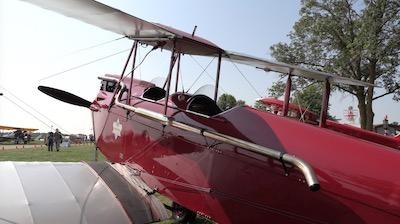One Man's Journey To An Award-Winning Vintage Airplane
By: Tom Patton
When Michael Maniatis came across the 1928 de Havilland Gipsy Moth he brought to AirVenture 2019, it was in pieces in a barn in Canada and was barely recognizable as an airplane. This year, it was one of the stars in the Vintage area, and became an award-winner.

Maniatis, acquired the airplane in 2014. It was one of the early examples of the Gipsy Moth, sold out of Lowell, MA to famed boat racer Gar Wood. Wood owned if for about three years he sold it to someone in Canada. Then, in 1943, the airplane was involved in a training accident, and the parts were "stuffed in a barn, as usual" Maniatis said, "and resurrected in 1978" at which time a restoration was started.
It didn't get very far, and in 2011, the restorer, who was a friend of Maniatis', passed away. Maniatis bought the parts in 2014, and began his own restoration project.
The restoration was extensive. "We pretty much had to replace all the wood," Maniatis said. "We had to completely rebuild the fuselage, the top decking, (and) the front fuselage."
Maniatis did a lot of research to be able to make his airplane as original as possible. He said he was given a lot of plans for the airplane when he bought it, but while he had much of the basics, he was not provided with information of many of the small details that would make it authentic. "A lot of the fittings had to be made from scratch. The plane is all about the details."
Among the details that add to the authenticity are the inclusion of original instruments, such as a British Husan compass mounted on the right side of the aft cockpit.

The Gipsy Moth is powered by a 120 horsepower Gipsy II engine. One of the things that is notable from just looking at the airplane is that the engine is above the propeller, with a long exhaust pipe leading well aft along the side of the fuselage, carrying the exhaust to a spot aft of the pilot in the rear cockpit. "The Gipsy I and Gipsy II engines were designed as upright engines," Maniatis said, which led to a problem with visibility. "Later on, they did invert the engine for the Tiger Moth. But you know, it's sweet. The design of the airplane, I think, is very esthetic, and everybody loves to look at that long exhaust. It's part of the character of the airplane, and it has a sweet sound to it."
Maniatis said that the first time he flew the airplane, he was nervous. "Not that I didn't have a lot of time in these airplanes, which I do, but you have to think about, building the airplane from scratch, you want to make sure everything's tight and safe and you've rigged it properly. But it flew really well right off the bat.

"It doesn't roll very fast, because it only has two ailerons, but it's a real rudder airplane," Maniatis said. "You can stand it on its tail, kick the rudder and it'll go right over. It likes to do loops."
Maniatis said the plane was famous for doing a maneuver called the "bunt" in which you point the nose straight down and then push through to inverted flight. "It likes to be inverted, although when you get to that point, the engine stops," he said.
The Gipsy Moth features folding wings, which Maniatis and his co-pilot, Mike Frohne, demonstrated during the show. Maniatis said it was designed that way because even in the 1920s and 1930s, hangar space was at a premium. The folding process is fairly quick ... remove a couple of pins and walk the wings back flush against the fuselage. That was a selling point for de Havilland. They would show pictures of owners taking their airplane out of a garage, towing it through town to an airport, and flying it away.
Maniatis and Frohne did not fly the airplane to AirVenture, but it did fly during the show, which is required for judging for vintage aircraft. To get the Gipsy Moth to AirVenture, they placed the airplane in a trailer and hauled it from upstate New York where they live to Wisconsin.
Maniatis has completed several other restorations. "I've done my Tiger Moth twice," he said, as well as a full restoration on another Tiger Moth and a J-5 Taylorcraft. He's built two other Moth-based airplanes from scratch, and is working on a third. "Those two were Moth Majors, which is very similar to this airplane, and a DH-71 racer, which is a racing airplane de Havilland built back in 1927.

The Gipsy Moth took second place in the Vintage Aircraft Association Silver Age Category, which is for airplanes built between 1928 and 1932. If you're in upstate New York, look for Maniatis flying this, or one of his other restored vintage airplanes in the skies overhead.
(Staff images)
 ANN's Daily Aero-Term (12.19.25): Ultrahigh Frequency (UHF)
ANN's Daily Aero-Term (12.19.25): Ultrahigh Frequency (UHF) NTSB Prelim: Cirrus Design Corp SR22T
NTSB Prelim: Cirrus Design Corp SR22T Classic Aero-TV: The Red Tail Project--Carrying the Torch of the Tuskegee Airmen
Classic Aero-TV: The Red Tail Project--Carrying the Torch of the Tuskegee Airmen Aero-News: Quote of the Day (12.19.25)
Aero-News: Quote of the Day (12.19.25) Airborne 12.17.25: Skydiver Hooks Tail, Cooper Rotax Mount, NTSB v NDAA
Airborne 12.17.25: Skydiver Hooks Tail, Cooper Rotax Mount, NTSB v NDAA






